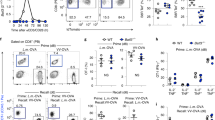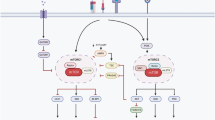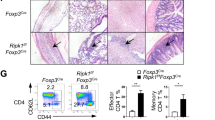Abstract
CD4+ T cells are important in adaptive immunity, but their dysregulation can cause autoimmunity. Here we demonstrate that the multifunctional adaptor protein β-arrestin 1 positively regulated naive and activated CD4+ T cell survival. We found enhanced expression of the proto-oncogene Bcl2 through β-arrestin 1–dependent regulation of acetylation of histone H4 at the Bcl2 promoter. Mice deficient in the gene encoding β-arrestin 1 (Arrb1) were much more resistant to experimental autoimmune encephalomyelitis, whereas overexpression of Arrb1 increased susceptibility to this disease. CD4+ T cells from patients with multiple sclerosis had much higher Arrb1 expression, and 'knockdown' of Arrb1 by RNA-mediated interference in those cells increased apoptosis induced by cytokine withdrawal. Our data demonstrate that β-arrestin 1 is critical for CD4+ T cell survival and is a factor in susceptibility to autoimmunity.
This is a preview of subscription content, access via your institution
Access options
Subscribe to this journal
Receive 12 print issues and online access
$209.00 per year
only $17.42 per issue
Buy this article
- Purchase on Springer Link
- Instant access to full article PDF
Prices may be subject to local taxes which are calculated during checkout





Similar content being viewed by others
References
Marrack, P. & Kappler, J. Control of T cell viability. Annu. Rev. Immunol. 22, 765–787 (2004).
Stockinger, B., Kassiotis, G. & Bourgeois, C. Homeostasis and T cell regulation. Curr. Opin. Immunol. 16, 775–779 (2004).
Strasser, A. & Pellegrini, M. T-lymphocyte death during shutdown of an immune response. Trends Immunol. 25, 610–615 (2004).
Bidere, N., Su, H.C. & Lenardo, M.J. Genetic disorders of programmed cell death in the immune system. Annu. Rev. Immunol. 24, 321–352 (2006).
Hughes, P., Bouillet, P. & Strasser, A. Role of Bim and other Bcl-2 family members in autoimmune and degenerative diseases. Curr. Dir. Autoimmun. 9, 74–94 (2006).
Marsden, V.S. & Strasser, A. Control of apoptosis in the immune system: Bcl-2, BH3-only proteins and more. Annu. Rev. Immunol. 21, 71–105 (2003).
Hengartner, M.O. The biochemistry of apoptosis. Nature 407, 770–776 (2000).
Strasser, A., O'Connor, L. & Dixit, V.M. Apoptosis signaling. Annu. Rev. Biochem. 69, 217–245 (2000).
Bouillet, P. et al. Proapoptotic Bcl-2 relative Bim required for certain apoptotic responses, leukocyte homeostasis, and to preclude autoimmunity. Science 286, 1735–1738 (1999).
Strasser, A., Harris, A.W. & Cory, S. Bcl-2 transgene inhibits T cell death and perturbs thymic self-censorship. Cell 67, 889–899 (1991).
Hildeman, D.A. et al. Activated T cell death in vivo mediated by proapoptotic Bcl-2 family member Bim. Immunity 16, 759–767 (2002).
Grayson, J.M., Zajac, A.J., Altman, J.D. & Ahmed, R. Cutting edge: increased expression of Bcl-2 in antigen-specific memory CD8+ T cells. J. Immunol. 164, 3950–3954 (2000).
Veis, D.J., Sorenson, C.M., Shutter, J.R. & Korsmeyer, S.J. Bcl-2-deficient mice demonstrate fulminant lymphoid apoptosis, polycystic kidneys, and hypopigmented hair. Cell 75, 229–240 (1993).
Strasser, A. et al. Enforced BCL2 expression in B-lymphoid cells prolongs antibody responses and elicits autoimmune disease. Proc. Natl. Acad. Sci. USA 88, 8661–8665 (1991).
Dewire, S.M., Ahn, S., Lefkowitz, R.J. & Shenoy, S.K. β-Arrestins and cell signaling. Annu. Rev. Physiol. 69, 483–510 (2007).
Wilbanks, A.M. et al. Beta-arrestin 2 regulates zebrafish development through the hedgehog signaling pathway. Science 306, 2264–2267 (2004).
Chen, W. et al. Beta-arrestin 2 mediates endocytosis of type III TGF-beta receptor and down-regulation of its signaling. Science 301, 1394–1397 (2003).
Chen, W. et al. Activity-dependent internalization of smoothened mediated by β-arrestin 2 and GRK2. Science 306, 2257–2260 (2004).
Perry, S.J. & Lefkowitz, R.J. Arresting developments in heptahelical receptor signaling and regulation. Trends Cell Biol. 12, 130–138 (2002).
Luttrell, L.M. et al. Activation and targeting of extracellular signal-regulated kinases by β-arrestin scaffolds. Proc. Natl. Acad. Sci. USA 98, 2449–2454 (2001).
DeFea, K.A. et al. The proliferative and antiapoptotic effects of substance P are facilitated by formation of a β-arrestin-dependent scaffolding complex. Proc. Natl. Acad. Sci. USA 97, 11086–11091 (2000).
Kang, J. et al. A nuclear function of β-arrestin1 in GPCR signaling: regulation of histone acetylation and gene transcription. Cell 123, 833–847 (2005).
Ferguson, S.S., Barak, L.S., Zhang, J. & Caron, M.G. G-protein-coupled receptor regulation: role of G-protein-coupled receptor kinases and arrestins. Can. J. Physiol. Pharmacol. 74, 1095–1110 (1996).
Parruti, G. et al. Molecular analysis of human β-arrestin-1: cloning, tissue distribution, and regulation of expression. Identification of two isoforms generated by alternative splicing. J. Biol. Chem. 268, 9753–9761 (1993).
Walker, J.K. et al. Beta-arrestin-2 regulates the development of allergic asthma. J. Clin. Invest. 112, 566–574 (2003).
Wang, Y. et al. Association of β-arrestin and TRAF6 negatively regulates Toll-like receptor–interleukin 1 receptor signaling. Nat. Immunol. 7, 139–147 (2006).
DiSanto, J.P., Guy-Grand, D., Fisher, A. & Tarakhovsky, A. Critical role for the common cytokine receptor γ chain in intrathymic and peripheral T cell selection. J. Exp. Med. 183, 1111–1118 (1996).
Nakajima, H., Shores, E.W., Noguchi, M. & Leonard, W.J. The common cytokine receptor γ chain plays an essential role in regulating lymphoid homeostasis. J. Exp. Med. 185, 189–195 (1997).
Ben-Sasson, S.Z., Makedonski, K., Hu-Li, J. & Paul, W.E. Survival and cytokine polarization of naive CD4+ T cells in vitro is largely dependent on exogenous cytokines. Eur. J. Immunol. 30, 1308–1317 (2000).
Kane, L.P. & Weiss, A. The PI-3 kinase/Akt pathway and T cell activation: pleiotropic pathways downstream of PIP3. Immunol. Rev. 192, 7–20 (2003).
Gendron, S., Couture, J. & Aoudjit, F. Integrin α2 β1 inhibits Fas-mediated apoptosis in T lymphocytes by protein phosphatase 2A-dependent activation of the MAPK/ERK pathway. J. Biol. Chem. 278, 48633–48643 (2003).
Scott, M.G. et al. Differential nucleocytoplasmic shuttling of β-arrestins. Characterization of a leucine-rich nuclear export signal in β-arrestin2. J. Biol. Chem. 277, 37693–37701 (2002).
Wang, P., Wu, Y., Ge, X., Ma, L. & Pei, G. Subcellular localization of β-arrestins is determined by their intact N domain and the nuclear export signal at the C terminus. J. Biol. Chem. 278, 11648–11653 (2003).
Jambal, P. et al. Cytokine-mediated down-regulation of the transcription factor cAMP-response element-binding protein in pancreatic β-cells. J. Biol. Chem. 278, 23055–23065 (2003).
Tamatani, M. et al. Tumor necrosis factor induces Bcl-2 and Bcl-x expression through NFκB activation in primary hippocampal neurons. J. Biol. Chem. 274, 8531–8538 (1999).
Ogryzko, V.V., Schiltz, R.L., Russanova, V., Howard, B.H. & Nakatani, Y. The transcriptional coactivators p300 and CBP are histone acetyltransferases. Cell 87, 953–959 (1996).
Sospedra, M. & Martin, R. Immunology of multiple sclerosis. Annu. Rev. Immunol. 23, 683–747 (2005).
Bettelli, E. et al. Reciprocal developmental pathways for the generation of pathogenic effector TH17 and regulatory T cells. Nature 441, 235–238 (2006).
Vroon, A., Lombardi, M.S., Kavelaars, A. & Heijnen, C.J. Changes in the G-protein-coupled receptor desensitization machinery during relapsing-progressive experimental allergic encephalomyelitis. J. Neuroimmunol. 137, 79–86 (2003).
Zang, Y.C., Hong, J., Rivera, V.M., Killian, J. & Zhang, J.Z. Human anti-idiotypic T cells induced by TCR peptides corresponding to a common CDR3 sequence motif in myelin basic protein-reactive T cells. Int. Immunol. 15, 1073–1080 (2003).
Oakley, R.H., Laporte, S.A., Holt, J.A., Caron, M.G. & Barak, L.S. Differential affinities of visual arrestin, β arrestin1, and β arrestin2 for G protein-coupled receptors delineate two major classes of receptors. J. Biol. Chem. 275, 17201–17210 (2000).
Nguyen, K. & Miller, B.C. CD28 costimulation induces delta opioid receptor expression during anti-CD3 activation of T cells. J. Immunol. 168, 4440–4445 (2002).
Zhang, J. & Hutton, G. Role of magnetic resonance imaging and immunotherapy in treating multiple sclerosis. Annu. Rev. Med. 56, 273–302 (2005).
van Oosten, B.W. et al. Treatment of multiple sclerosis with the monoclonal anti-CD4 antibody cM-T412: results of a randomized, double-blind, placebo-controlled, MR-monitored phase II trial. Neurology 49, 351–357 (1997).
Rep, M.H. et al. Treatment with depleting CD4 monoclonal antibody results in a preferential loss of circulating naive T cells but does not affect IFN-γ secreting TH1 cells in humans. J. Clin. Invest. 99, 2225–2231 (1997).
Wang, P. et al. Beta-arrestin 2 functions as a G-protein-coupled receptor-activated regulator of oncoprotein Mdm2. J. Biol. Chem. 278, 6363–6370 (2003).
Sun, Y., Cheng, Z., Ma, L. & Pei, G. Beta-arrestin2 is critically involved in CXCR4-mediated chemotaxis, and this is mediated by its enhancement of p38 MAPK activation. J. Biol. Chem. 277, 49212–49219 (2002).
Ota, K. et al. T-cell recognition of an immunodominant myelin basic protein epitope in multiple sclerosis. Nature 346, 183–187 (1990).
Zappia, E. et al. Mesenchymal stem cells ameliorate experimental autoimmune encephalomyelitis inducing T-cell anergy. Blood 106, 1755–1761 (2005).
Acknowledgements
We thank R.J. Lefkowitz (Duke University Medical Center) for rabbit polyclonal anti-β-arrestin (A1CT) and for Arrb1−/− and Arrb2−/− mice; Y. Shi, J. Cai and X. Liu for discussions; and S. Xin, Y. Li, G. Ding, P. Wu and S. Chen for technical assistance. Supported by the Ministry of Science and Technology (2003CB515405 and 2005CB522406), the National Natural Science Foundation of China (30021003, 30623003, 30625014, 30400230, 30430650 and 30571731), the Shanghai Municipal Commission for Science and Technology (06ZR14098, 04JC14040, 04DZ14902 and PJ200500330), the Shanghai Municipal Health Bureau (LJ06046), the Shanghai Leading Academic Discipline Project (T206) and the Chinese Academy of Sciences (KSCX2-YW-R-56).
Author information
Authors and Affiliations
Contributions
Y.S. designed and did the experiments and prepared the manuscript; Y.F. and J.K. designed and did the experiments and analyzed the data; C.L. assisted with cell purification, activation and culture; Z.L., Z.G. and C.L. provided the blood samples from patients with multiple sclerosis; D.L. prepared the manuscript; W.C. and J.Q. assisted with the induction of EAE; E.B. and L.Z. assisted with cell purification, activation and culture; and J.Z.Z. and G.P. supervised all studies and the preparation of the manuscript.
Corresponding authors
Ethics declarations
Competing interests
The authors declare no competing financial interests.
Supplementary information
Supplementary Text and Figures
Supplementary Figures 1–7 and Supplementary Methods (PDF 2619 kb)
Rights and permissions
About this article
Cite this article
Shi, Y., Feng, Y., Kang, J. et al. Critical regulation of CD4+ T cell survival and autoimmunity by β-arrestin 1. Nat Immunol 8, 817–824 (2007). https://doi.org/10.1038/ni1489
Received:
Accepted:
Published:
Issue Date:
DOI: https://doi.org/10.1038/ni1489
This article is cited by
-
Hepatic β-arrestins: potential roles in liver health and disease
Molecular Biology Reports (2023)
-
Exploring the biological function of immune cell-related genes in human immunodeficiency virus (HIV)-1 infection based on weighted gene co-expression network analysis (WGCNA)
BMC Medical Genomics (2022)
-
Opposing functions of β-arrestin 1 and 2 in Parkinson’s disease via microglia inflammation and Nprl3
Cell Death & Differentiation (2021)
-
Targets and regulation of microRNA-652-3p in homoeostasis and disease
Journal of Molecular Medicine (2021)
-
Dopamine D2 receptor restricts astrocytic NLRP3 inflammasome activation via enhancing the interaction of β-arrestin2 and NLRP3
Cell Death & Differentiation (2018)



